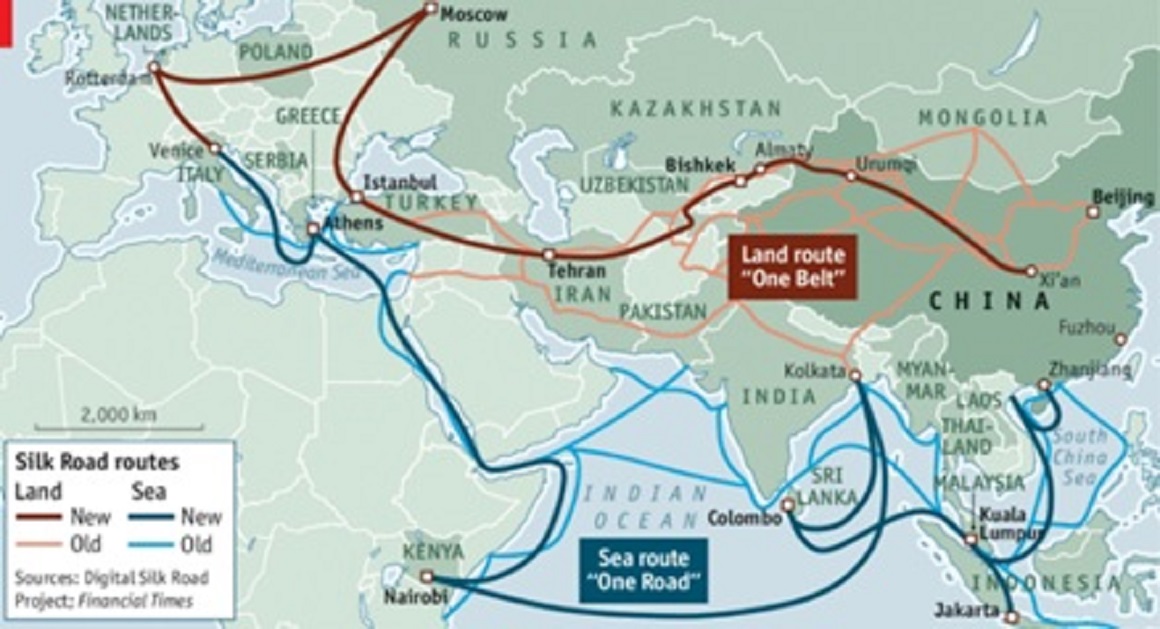China, in Xi Jinping’s words, is a building a “new model” of major-country relations, and crafting a policy of building relations with neighbouring countries, based on “amity, mutual benefit and inclusiveness”.
Geographically speaking, China is an Asia Pacific country. It has 22 neighbours. In its multi-dimensional foreign and security policy, Asia, in its broadest sense, figures in a big way. China is expanding relationship with all regions of Asia and Asia Pacific namely South East Asia, Central Asia, West Asia, South Asia, South-East Asia and Eurasia. On the maritime front, China is extending its influence across the Indo-Pacific region. Thus China’s policy have both continental as well as maritime dimensions. In fact they are interlinked. The Belt and Road Iniiative (BRI) is an ambitious project of Xi Jinping aimed at expanding China’s influence in all region of Asia and beyond.
India is also a major Asian country, with 4000 Km long border with China which has yet not been demarcated. This puts a major constraint on further development of Sino-Indian relations. China-Pakistan-Economic-Corridor (CPEC) which passes through the Indian territory of J&K has adverse political and security implications for India. The Belt and Road Initiative (BRI), also provides China an opportunity to expand its India’s neighbourhood. China projects BRI as a “public good” but the reality is very different as more and more countries find themselves in debt distress. BRI has prompted China to build new institution like the AIIB and Silk Road Fund, to fund connectivity between China and the neighbouring countries and beyond. India will be affected whether or not the BRI project succeeds. India’s neighboring countries can fall into unhealthy dependencies on China.
Security implications of BRI are considerable, as for instance in the case of CPEC which has brought the Chinese presence close to Indian border, whether in the Pakistan Occupied Kashmir (POK) or in the Sir Creek area. A new security force has been constituted in Pakistan ostensibly to protect the BRI assets. Border management will become that much more difficult. The implications of a Chinese naval base in Gwadar are self-evident. Within the past few years the Chinese submarines have appeared in the Bay of Bengal and Sri Lanka. The Chinese naval base in Djibouti, in the Indian Ocean, is also a matter of security concern for India. Chinese are also expanding their presence in Duqum in Oman.
Chinese occupation of disputed islands in the South China Sea and the construction of military facilities there, in disregard of the International Court of Justice (ICJ) judgment, is an indication of assertive Chinese behavior. The ongoing Code of Conduct negotiation between China and ASEAN is likely to produce a one-sided result because the status quo in South China Sea is tilted in favour of China. Indian economic interests and India’s relations with ASEAN countries are heavily impacted by the heavy present of China in ASEAN.
India’s decision to keep away from the RCEP, though justified in the context of the lack of competitiveness of the Indian industry, is nevertheless fraught with long-term implication for India’s Act East Policy. It opens the field further for China to further deepen its influence in ASEAN. The kind of balance which India could provide in the East Asian region will receive a set back as India has decided to keep away from the RCEP.
India has joined the Shanghai Cooperation Organisation (SCO), despite China’s reluctance and hesitation. SCO is heavily dominated by China. The lack of connectivity between India and Central Asia also limits India’s potential in the SCO. India’s involvement in the SCO is likely to remain confined to cooperation on counter-terrorism issues. The presence of Pakistan in the SCO and China’s support to it will ensure that the kind of pressure which needs to be put on Pakistan will not be possible.
Russia is pushing its agenda for Eurasian integration. But it cannot get away from a dipper economic integration with China. Although, there are concerns in Russia over China’s growing influence in Eurasia as well as the junior status of Russia, in a Russia-China partnership, Russia seems to have no alternative but to become a supplier of energy and primary resources to China. The inauguration of the pipeline Power of Siberia, which will provide 1 trillion cubic meters worth of natural gas to China in the next 30 years is a case in point. Russia is also enhancing its security cooperation with China at different levels. Russia, shunned by the West, is going deeper into the arms of China despite, long term adverse implications for Russia itself. In a Russia-India-China trilateral, which has endured for close to two decades, Russia- China side is the strongest. Even in BRICS, Russia and China dominate the grouping.
West Asia is an important region for India and China as both source their oil supplies to a considerable degree. China, through investment, trade and public diplomacy has succeeded in making a place for itself in the Middle East. Arabs have fully supported its BRI projects. China is considered a reliable partner in the region. In contrast, there are many doubts in the region about the US’ credibility.
While India has significantly upgraded its relationship with key countries in the region, China’s trade and investments relations are deep. China is making inroad into Iran, particularly in Chahabhar. It has been ahead of India in building railway infrastructure in Iran. India has failed to capitalize fully the potential of the International North South Trade Corridor (INSTC), Chabahar port and has taken few steps to help build the railway line from Chabahar to Zahedan. It has also been forced to reduce its oil purchases from Iran due to the US sanctions. India will find it increasingly difficult to maintain a balance between Iran on the one hand and Saudi Arabia on the other. China has been more successful in this regard, mainly because of its ability to stand up to America.
China-US trade war can potentially be beneficial for India. Many US and other companies are looking for alternative markets and destinations for investments. For this to happen, India has to act fast and make itself as an attractive destination. The slowing down of the Indian economy is a setback in that direction.
To sum up, the challenges before India arising out of China’s rise are as follows:
- The rising asymmetry between India and China make it difficult for India to convince China to settle the boundary question.
- China’s growing influence in South Asia at India’s expense.
- Security implication of CPEC, Chinese base in Gawadar, Djibouti etc.
- China’s activities to build and take control of ports in different countries in the Indian Ocean.
- China’s increasing military presence in the Indian Ocean.
- China’s technology edge, particularly in the telecommunication area (5G) which gives its company like Huawei it holds into the countries of the region in which India also have strong interest.
- China has used its space capabilities to attract India’s neighbour into cooperative folds.
- India’s neighbour follow policies of extracting maximum benefits from India and China rivalry and competition.
- China’s growing capabilities in education is attracting large number of Indian and South Asian student to it universities.
- China’s dominance in South East Asia will have an impact on India’s Act East Policy.
What should India do?
India can take several measures. These are as follows:
- Maintaining a working relationship with China without being confrontational. As the same time it has adopted a firm position on issues like the BRI, borders (Doklam crisis). This policy should continue. China should know India’s red line clearly.
- India has promoted the Quad. This cooperation should continue.
- India should strengthen its Act East Policy. It should keep its option of joining the RCEP eventually.
- India should strengthen its relations with Russia. It should be a partner with Russia in its Eurasia projects. India’s Act Far East policy should be implemented expeditiously.
- India has considerable soft power which can be harnessed to deal with Chinese influence in multiple ways. Civilization, culture and religion bind the people of the religion. India has an advantage in these areas.
- In particular, India can be a hub of education, healthcare, and tourism for the people in Asia. These areas should be developed.
- India should pay adequate attention to science and tech, research and development and innovation. Investment in these area will strengthen India’s capability and help development instrument to deal with China.
(The paper is the author’s individual scholastic articulation. The author certifies that the article/paper is original in content, unpublished and it has not been submitted for publication/web upload elsewhere, and that the facts and figures quoted are duly referenced, as needed, and are believed to be correct). (The paper does not necessarily represent the organisational stance... More >>
Image Source: http://cdn.ipsnews.net/Library/2018/02/china2.jpg











Post new comment